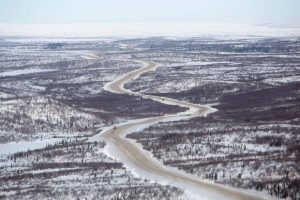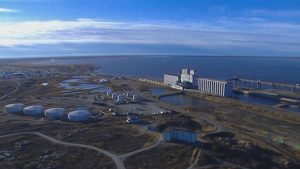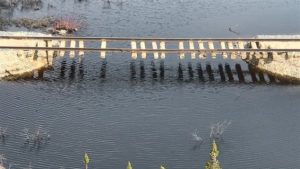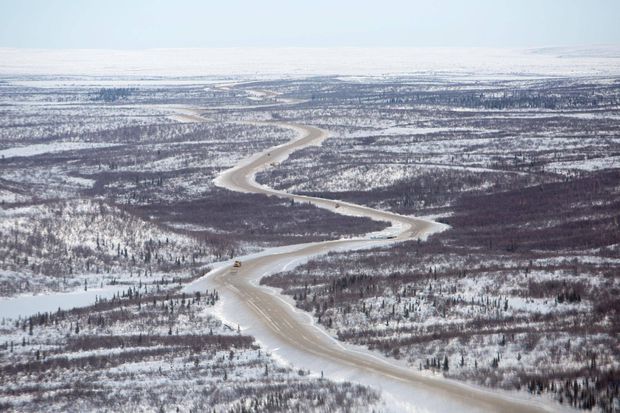This week marks the opening of Canada’s first permanent road to the Arctic coast, linking the hamlet of Tuktoyaktuk and the town of Inuvik (Figure 1). This road represents decades of planning, years of construction, and significant financial investment by the Canadian government.

Source: JAMES MACKENZIE/THE CANADIAN PRESS
Meanwhile, several thousand kilometres away on Hudson Bay, Canada’s only Arctic port in Churchill, Manitoba, is dormant (Figure 2). The railway which served the important port has been inaccessible since May 2017. Many scientists blame regionally accelerated climate-change for exacerbating the damage, and this sort of problem is common throughout the Arctic.

Source: CBC
Transport infrastructure is important to Arctic communities, with a single line often being the only connection between isolated communities, and providing a route for vital supplies and imports. The closure of these routes can have far-reaching consequences on residents. In Churchill where the port closed in 2016 and the rail-line stopped functioning in 2017, food prices have skyrocketed, the tourist crowds have disappeared, and a trapped train still sits at the station. Just a five years earlier, the rail operator Omnitrax Canada had touted Churchill as the future anchor point for oil and gas shipping through the Arctic, promising investment and repairs to the ageing rail line since the 1990s. Now the company argued that the $60 million in damages to the train tracks (Figure 3) is too extensive and costly to repair without significant governmental and first-nations support.Meanwhile, local residents are feeling increasingly isolated as the service they have come to depend on comes no closer to functionality.

Source: OmniTrax
To ensure future operability, relevant stakeholders would need to finance repairs combined with a mitigation and adaption strategy to harden infrastructure against new levels of environmental impacts. The severity of these environmental stressors has been exacerbated by climate change and is projected to continue rising. These issues are pertinent throughout Arctic region, with ageing buildings and transport infrastructure in the Russian Arctic and Alaska also being impacted by ongoing climate change. This is a preview of the future which might be in store for newly built infrastructure. The need to mitigate and adapt to eventual climate-change impacts must be considered in the planning and development of future projects.
The infrastructure which is already built in the Arctic has been shown to be at risk and will require significant investments in mitigation and adaption to continue operating as intended. Meanwhile, the construction of new infrastructure continues and is planned in many regions, undeterred by the experiences of their northern neighbours. Any construction in the Arctic is very costly as a result of the remote location and because of the unique geotechnical challenges that must be addressed. The newly opened all-weather gravel road, from Inuvik to Tuktoyaktuk, NT, will be 120 km long and cost over $300 million, about $2.5 million per kilometre. The road represents only the start of the Northwest Territory’s development plans, with routes being planned in the regions around Yellowknife, Nunavut, and the Mackenzie Valley. These sorts of new developments are an attractive and flashy investment for policymakers, pleasing constituents and big business alike. Funding their maintenance and upkeep over the long term is a less politically appealing matter.
Investments in new infrastructure will certainly benefit local peoples and the economy, but they will never be without significant future costs. The Churchill Port and rail were major projects of their time, just as the Inuvik-Tuktoyaktukroad Highway is now. Both infrastructure projects were hailed as groundbreaking, opening new territories and connecting underserved populations. However, when the Inuvik-Tuktoyaktukroad Highway is inevitably faced with mitigating expensive climate-change impacts, as the Churchill Port and rail are now, the costs will quickly rise and continued support is not guaranteed. In Manitoba, rising repair costs are being cited as an argument to abandon the infrastructure altogether and OmniTrax is looking to sell its stake in the project, showing the transient nature of support for Arctic infrastructure projects. Though the Manitoba government has promised to help future owners fund repairs, the practical release of these funds remains uncertain.
In many cases, the companies and governments responsible for repairs are inhibited by high-costs and the desire to invest in new development rather than upkeep existing infrastructures. While the mood along the Inuvik-Tuktoyaktukroad Highway is high – as it should be – these communities must temper their long-term expectations. While planning for the growth that will come with the new road is beneficial, it is equally useful to plan for scenarios when the route is damaged and investment is less forthcoming.
